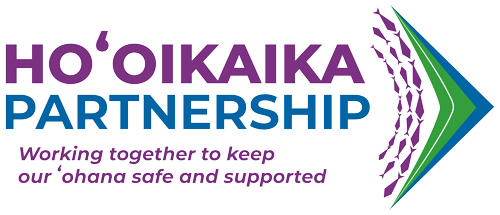Strategic Plan
In 2021, the Hoʻoikaika Partnership engaged in a strategic planning process to identify goals for the next three years. This process was facilitated by external consultants, The Stellar Group, and took place through a series of three meetings, all held virtually via Zoom conferencing platform on February 24th – 26th. The planning sessions were open to all partners, with a total of 46 participants. Five additional meetings were held with partners in March to refine the goals, objectives, and activities, as well as one final meeting in April to revise the mission, vision, and values.
Goals
- Create a seamless safety net of services to support children and their caregivers.
- Strengthen the prevention and provider workforce.
- Successfully educate and advocate for policy, program, and systems changes to prevent child abuse and neglect.
- Engage the community in prevention of child abuse and neglect.
- Strengthen the foundation of the Ho‘oikaika Partnership.
1. Create a seamless safety net of services to support children and their caregivers.
A 2016 Service Gap Analysis identified challenges in coordinating services for Maui Island families and children involved with Child Welfare Services (CWS). Creating a “seamless system” means improving communication and documentation between CWS, providers, and families to help everyone be on the same page regarding case status, services availability, referrals, roles and expectations, program requirements and contract limitations, and discharge readiness. An integrated, shared referral platform, assessment and intake process would improve service coordination and reduce the burden on families trying to access services.
In the absence of that, our Systems Navigator helps facilitate communication, referrals to services, and access to concrete supports for families while also helping weave a stronger safety net among providers.
2. Strengthen the prevention and provider workforce
We provide training and professional development for staff in partner agencies to improve both the quality and cultural relevance of services delivered to families and children. Training on the Protective Factors helps to develop a common language and framework for working with families. We also work to improve the cultural competence and sensitivity of the Maui County prevention and provider workforce and expand diversity within the workforce. The annual Ho’oikaika Conference is one of the primary ways we build our capacity as health and human service providers.
3. Successfully educate and advocate for policy, program, and systems changes to prevent child abuse and neglect.
Education and advocacy are powerful ways to create systems-level change in the county, state, and nation. This means raising up the voices of parents, caregivers, and youth with lived experience alongside providers to improve how programs and organizations operate to better prevent child abuse and neglect. We work with other statewide groups to inform the development of their advocacy agendas and share relevant information with partners and the broader community. Our short-term priorities are to strengthen relationships with policy- and decision-makers and build a formal network of people to educate and advocate for needed policy, program, and systems changes.
4. Engage the community in prevention of child abuse and neglect.
We host community events that promote family strengthening and other child abuse and neglect prevention strategies and invite communities to share stories around needs and barriers to accessing services. As a community, greater understanding and awareness of child abuse and neglect can help reduce risk factors, provide supports, promote resiliency, and reduce stigma for families seeking services. It can also help community members learn how to identify child abuse and neglect and how to respond.
5. Strengthen the foundation of the Ho‘oikaika Partnership.
Strong engagement from agency partners has enabled our coalition to carry out a variety of child abuse prevention projects over our long history. Now, we need to build a more formal infrastructure so we can successfully achieve the mission and goals in our strategic plan. Establishing new partner agreements and roles, developing new communication and technology tools, evaluating progress, and securing sufficient funding to sustain the partnership will enable us to increase our collective impact.
Research to Understand Child and Family Service Needs in Maui County
In recognition of 2022 Child Abuse Prevention month, the Ho’oikaika Partnership released a report that helps us better understand child and family service needs and pandemic impacts. Conducting this research is part of our Strategic Plan.
The Stellar Group examined existing data from the last five years, focusing on the most common risk and protective factors for Maui County children and families, supports available to prevent child maltreatment, and the service gaps that exist.
Key Findings
-
- Reflecting our housing crisis, inadequate housing is cited as a precipitating factor in child removal more than twice as often in Maui County as statewide.
- Heavy continuous childcare and inability to cope with parental responsibility are also cited much more often in Maui County than statewide.
- In FFY21, there were 212 children from Maui County in foster care and Native Hawaiian children are disproportionately represented.
- Workforce challenges are common and affect the quality and continuity of services, especially due to issues with recruitment, retention, and cultural competence.
- It’s difficult to know what’s working and what’s not – program outcome data is limited and families’ own voices and experiences are lacking from research and data.
- There is some good news – child maltreatment rates in Hawai’i are lower than the rest of the United States.



